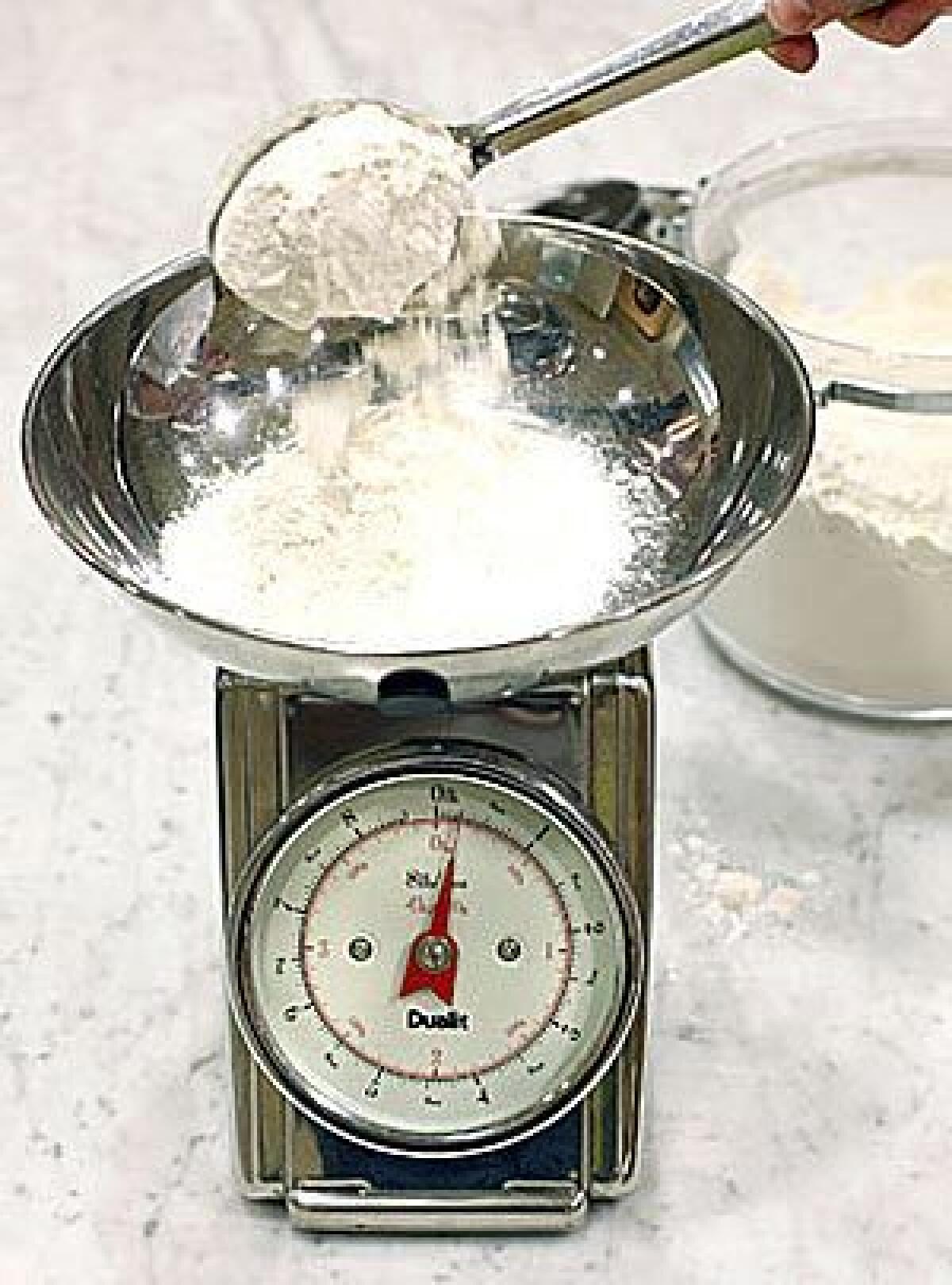For precise cooking, get on the kitchen scale

- Share via
I didn’t wake up one morning wanting to be a scale evangelist, honest. The urge grew gradually. But now, as America’s kitchens fill with useless gadgets -- mango slicers, slider molds, cherry pitters, egg separators (what happened to hands?!) -- but still no scale in sight, I’m compelled to put on my Ernest Angley wig and spread the word.
It began when I set out to write a book about ratios -- that is, learning to cook using proportions of ingredients rather than set amounts. Not wanting to exclude people who didn’t have a scale (i.e., most of America), I figured I needed to tell people that if they didn’t have a scale, they could figure a cup of flour weighed about so many ounces.
So I scooped a cup of flour out of the bag and weighed it -- 5.15 ounces. I poured the same flour into a mixing bowl, stirred it with a whisk and then scooped a cup out of that -- 4.3 ounces. As I continued to weigh my flour as I moved through the book, I got weights for a cup of flour as high as 6 ounces and as low as 4 ounces.
It slowly dawned on me what this meant: If my recipe for bread told me to combine four cups of flour and 1 1/2 cups of water, there could be as much as a 50% difference in the amount of flour I used. The dough with more flour might be so dry and dense that kneading would be difficult. Anyone using it might well think, “This is a crummy recipe, and the person who wrote it doesn’t know how to make bread!” At the same time, the one with less flour would be slack and sticky and difficult to work with.
How much in a cup?
The potential for a 50% difference in a main ingredient is a substantial hazard to home cooks. Imagine if you were making a custard and the instructions told you to add four eggs to two or three cups of milk? The custard with two cups of milk would set up perfectly and the one with three cups might look more like soup. And yet, when it comes to foods made with dry ingredients like flour, because we are so resistant to using scales, so wedded to our cup measures, we could forever be saddled with recipes that sometime work and sometimes don’t.
Clearly, it’s not necessarily the recipe that confounds our work in the kitchen so much as it is not having the right tools. Imagine a carpenter who had to trade in his folding ruler for a set of sticks that were cut at designated lengths: 1/2 inch, 1 inch, 2 inches, 4 inches and 12 inches. I wouldn’t want him building my bookshelves.
A baker without a scale is in a similar predicament of imprecision. A cup of all-purpose flour in one kitchen will probably be a different amount than a cup of all-purpose flour in another. But a pound of flour in my kitchen will almost always be very close to a pound of flour in yours (give or take some humidity).
The good folks at Cook’s Illustrated, whose super-nerd approach to cooking is dear to my heart, have addressed this, and while they too recommend measuring flour with a scale, not a cup, they nevertheless continue to give in to America’s reluctance to own and use a scale, and so have done tests on the best way to measure flour by volume.
In a video on their site, they test dipping a cup into flour and sweeping off the excess with a knife, and spooning flour into the measuring cup. They recommend the dip-and-sweep method because it gives you more flour. And in my book, I suggest that people should figure a cup of flour weighs about 5 ounces.
Proper proportions
But there’s more to my scale evangelism than consistency. By learning to look at ingredients by weight, the hidden structures of cooking are revealed.
If I know that pasta dough is 3 parts flour and 2 parts egg, I can simply crack the eggs into the bowl (two large eggs weigh about 4 ounces) and pour in 3 parts flour (or 6 ounces to the two eggs). I can easily double that -- 8 ounces of eggs and 12 ounces of flour -- and still have perfect pasta dough every time.
Measuring by weight also makes mixing, cooking and cleaning up faster and easier.
For example: If I know that bread is 5 parts flour and 3 parts water, I can simply put my mixing bowl on a scale, hit the “tare” or zeroing button, and pour, say, 10 ounces of flour into the bowl, hit tare again, then pour in 6 ounces of water, and that, plus some yeast and salt, will give me a nice small loaf or enough dough for a medium pizza. All in about five minutes.
As more and more Americans head into the kitchen to cook, they increasingly look to professional kitchens to help guide them. One thing all pastry chefs will tell you is that using a scale is the best, easiest and most consistent way to measure. And not just flour, but eggs and oil and all the other fundamental ingredients that form the backbone of our cooking.
With all of our spending on kitchen tools, including ridiculous gadgets, fine knives and heavy-gauge sauté pans, it continues to astonish me that more attention isn’t paid to the common scale.
Ruhlman is the author of “Ratio: The Simple Codes Behind the Craft of Everyday Cooking.”
More to Read
Eat your way across L.A.
Get our weekly Tasting Notes newsletter for reviews, news and more.
You may occasionally receive promotional content from the Los Angeles Times.










